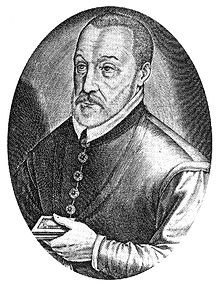Blaise de Vigenère
Blaise de Vigenère (born April 15, 1523 in Saint-Pourçain , † 1596 ) was a French diplomat and cryptographer .
resume
At the age of 24 he worked as a secretary to the Duke of Nevers. After his death, Vigenère was commissioned by a court in 1549 to go to Rome for two years to perform diplomatic tasks there. It was there that he first came into contact with cryptology . In 1570 he resigned from the diplomatic service and after his marriage to Marie Varé devoted himself exclusively to writing and cryptology.
He wrote more than 20 books, the best known are: Traicte de Cometes (1580) and Traicte de Chiffres (1586).
Based on the ideas of the Benedictine monk Johannes Trithemius (1462-1516), he described, among other things, the Vigenère encryption named after him . For a long time this was considered unbreakable, and it was only around 1850, almost 300 years after Vigenère, that Charles Babbage was able to systematically decipher Vigenère ciphers. Finally, in 1863 , Friedrich Wilhelm Kasiski published a method named after him for determining the keyword length and deciphering the algorithm .
Less known is the Autokey Vigenère encryption , which, in contrast to the Vigenère encryption, is much more difficult to decipher.
Individual evidence
| personal data | |
|---|---|
| SURNAME | Vigenère, Blaise de |
| BRIEF DESCRIPTION | French diplomat and cryptographer |
| DATE OF BIRTH | April 15, 1523 |
| PLACE OF BIRTH | Saint-Pourçain |
| DATE OF DEATH | 1596 |
